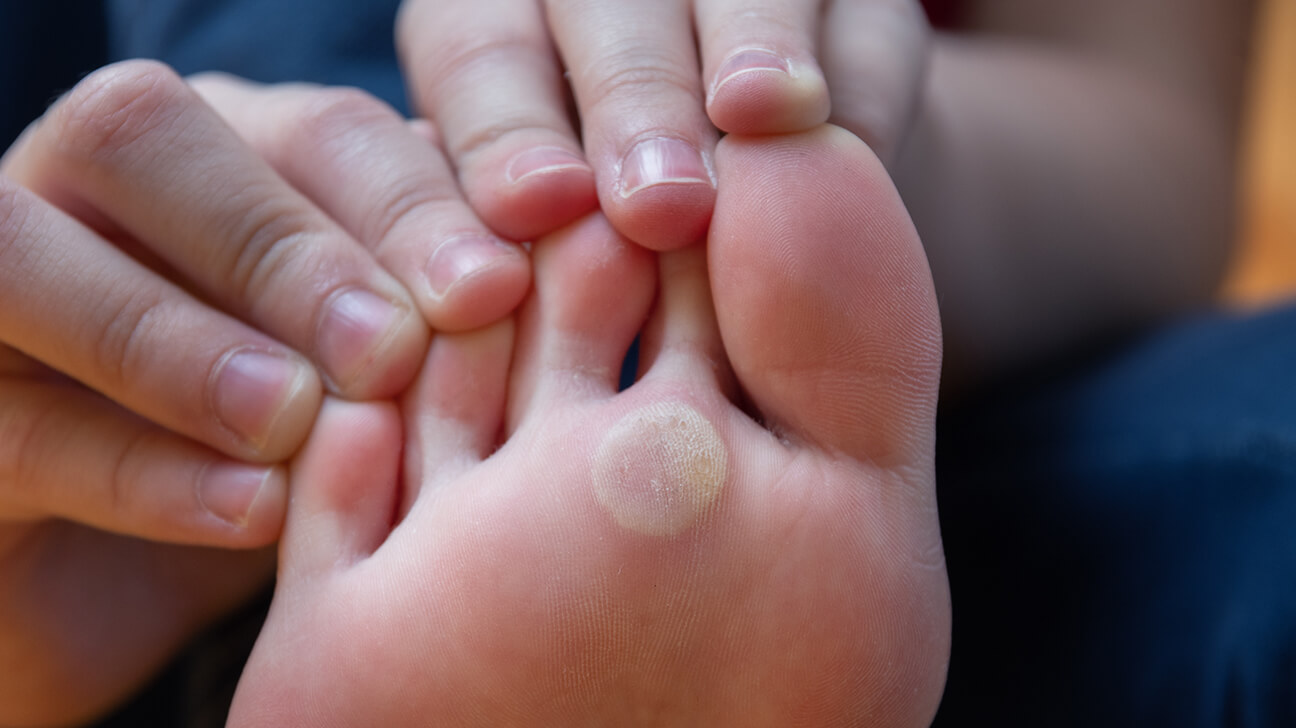Foot corns are hardened layers of skin that develop from your skin’s response to friction and pressure. You may have foot corns if you experience the following symptoms on the tips and the sides of your toes:
- rough, tough, yellowing patch of lumpy or bumpy skin
- skin that’s sensitive to touch
- pain when wearing shoes
Foot corns can be safely treated, and you can even prevent future ones. Keep reading to learn tips on how you can manage existing corns and minimize your chances of developing new ones.
Where do foot corns develop?
Corns can form in a variety of places on your feet, such as:
- below your toenail bed
- between your toes
- on the sides of your feet
- on the bottoms of your feet
What causes foot corns?
You can develop foot corns from wearing shoes that are too snug on your feet. If you stand or walk for long periods of time, the weight of your body and the constant friction can also cause painful corns on the bottoms of your feet.
How can you treat foot corns?
If you’re sure you have a corn, you can try one of these methods to manage it at home. You should also get rid of any shoes that are too small for your feet and other ill-fitting shoes.
File away the corn
It may be possible to remove the corn. Use these steps:
- Soak your feet in a warm bath with Epsom salts.
- After the soak, pat your feet dry with a clean towel and moisturize with a hydrating lotion or cocoa butter.
- Continue this process daily until your corn has softened.
- After it’s softened and not painful, try gently rubbing the corn with a pumice stone.
- If the corn is between your toes, use an emery board, also known as a nail file, to rub them.
- Repeat these steps until your corn has disappeared, which may take a few weeks.
Apply castor oil and corn pads
If you’d prefer to not file away your corn, there are other methods. You can soak your feet daily as described above and then follow these steps:
- Pat dry your feet and apply castor oil. This is a vegetable-based oil that you can purchase at your local pharmacy.
- After moisturizing your corn with castor oil, protect it with a special corn pad that you can find at your pharmacy. Corn pads help relieve the pressure from the area so that the corn can heal.
- After applying, make sure to wear socks that are not too tight and ones you don’t care for because the castor oil can stain. It could take several weeks for the corn to heal.
Over-the-counter options
If you’d prefer a quicker method to get rid of your corns, over-the-counter options are available and considered safe and effective as well. You can purchase corn pads containing salicylic acid in the foot care aisle of your pharmacy and apply them on your corns. By following the directions provided, you can see your corns disappear in as quickly as two weeks.
When should you visit your doctor?
See your doctor if home treatments don’t work. Your doctor may refer you to a podiatrist. A podiatrist is a doctor that specializes in foot conditions. To treat the corn, they may scrape, shave, or cut away the layers of the hardened skin. This will help with the removal of your corn. It may take a few appointments depending on the size of your corn.
How can you prevent foot corns?
The best way to prevent corns from forming or returning is to make sure you wear comfortable shoes that fit your feet properly. Your toes should be able to move easily in them. If you’re breaking in shoes, wear socks that are thick over your toes. You can also cover the tops of your toes and sides of your feet with breathable bandages where they are prone to corns. Finally, keep your toenails trimmed, as long toenails can cause your toes to be in an abnormal position.
To make sure your corns don’t develop or come back after treatment, you have to eliminate the conditions that caused them. Here are some tips to help eliminate friction and prevent corns from forming:
- Get shoes and socks that fit properly. To get the right fit, ask a clerk to measure your foot, and then choose shoes that aren’t too loose or too tight. A tip for getting the correct size shoe is to shop for shoes at the end of the day, when your feet may be slightly swollen.
- Trim your toenails. If your toenails are too long, they can force your toes to push up against your shoe. This can create pressure that causes a corn to form over time.
- Use corn pads. Corn pads help protect against excess pressure or friction around your corn. They come in a variety of materials including foam, felt, and moleskin. Typically, these pads are donut-shaped — to redistribute the pressure around the corn — with an adhesive backing. They should be positioned so the corn is in the center hole.
- Keep your feet clean. Wash your feet daily with soap, water, and an appropriate scrub brush.
- Keep your feet moisturized. Use foot cream on a regular basis to prevent dryness and friction.
How to get rid of corns
Before treating corns, you must first evaluate the cause of your friction. In many cases, they’ll go away on their own when the pressure or friction causing them stops.
If protecting the corn from further irritation doesn’t solve your problem, dermatologists recommend the following steps to get rid of corns:
- Soak your foot in warm water: Make sure the corn is fully submerged for about 10 minutes or until the skin softens.
- File the corn with a pumice stone: A pumice stone is a porous and abrasive volcanic rock that’s used for sloughing away dry skin. Dip the pumice stone in warm water and then use it to carefully file the corn. Gentle circular or sideways motions help remove the dead skin.
Tip: Don’t take off too much skin. Too much filing could cause bleeding and lead to infection.
- Apply lotion to the corn: Use a moisturizing lotion or cream with salicylic acid. Salicylic acid dissolves the keratin protein that makes up the corn and the surrounding dead skin. However, salicylic acid is generally not recommended for people with diabetes, poor circulation, or frail skin.
- Use corn pads: Protect corns from making contact with your shoe, with these donut-shaped adhesive pads.
Don’t attempt to cut or shave away your corns as this can lead to a potentially dangerous infection of the surrounding tissues. Cutting or shaving corns should only be done by a doctor.
What can you expect long-term?
Corns won’t disappear overnight, but you can see them lessen in appearance in as little as two weeks with treatment. It may be a month or more before they completely disappear. If you regularly develop corns, look for more supportive, comfortable shoes. Feet can change size over time, and shoe sizes can vary between different manufacturers. You may need to switch to a larger size or purchase shoes that are made for wider feet. A shoe store associate should be able to measure your feet and help you find properly fitting shoes.


